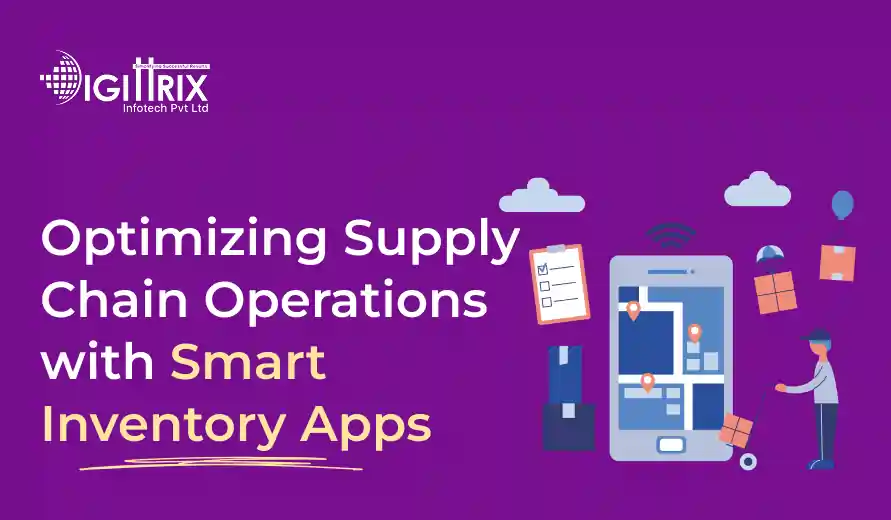Modern supply chains depend on inventory management apps for real-time tracking, precise stock control, and quicker decision-making to minimize losses and boost overall operational efficiency.
Highlights
An enthusiastic developer and skilled business management expert with over a decade of experience in the field

In today’s competitive market, supply chains are crucial for businesses that depend on timely delivery, efficient inventory management, and accurate data handling. A company’s success often depends on how well it manages its products from the supplier to the customer. One of the most important tools modern companies use for this process is an inventory management app. These apps offer a systematic approach to stock management, order processing, and overall logistics, helping businesses minimize losses and maintain operational control.
Every business faces challenges in maintaining a smooth supply chain. Whether it’s handling sudden demand changes, addressing warehouse inefficiencies, or managing shipping delays, even small mistakes can lead to significant losses. In the past, manual record-keeping made it difficult to track product movement accurately, causing errors and overstocking. As companies expanded, the need for automation in supply chain management became more obvious.
An improved approach with digital inventory tools helps companies avoid confusion and boost operational accuracy. Instead of relying on large registers or spreadsheets, companies now use apps that provide real-time stock visibility and tracking.
Looking to enhance your inventory management? Discover Digittrix’s expert guide to streamline your operations with cloud-based solutions!
The main purpose of using an inventory management app is to effectively monitor, organize, and control product stock. These apps allow businesses to track items from purchase to sale, and even after delivery if necessary. Having real-time data helps prevent shortages or excess inventory and ensures smooth coordination between suppliers and warehouses.
Inventory control extends beyond warehouses. With multi-location businesses and eCommerce platforms, having centralized access to data is essential. Digital inventory solutions provide real-time information that can be accessed from anywhere.
A cloud-based web-driven inventory management app allows businesses to access their data from any device at any time. This design removes the limit of data being stored on just one computer or local server. Cloud storage also supports real-time collaboration among departments, suppliers, and logistics teams.
For example, when stock arrives at a warehouse, the system automatically updates the central database. This information can then be viewed instantly by sales teams, managers, or even vendors. The use of a cloud-based web inventory tracking app also improves security and reduces the risk of data loss, as all data is stored in a protected online environment.
Creating a strong and user-friendly inventory solution requires careful planning. The process of developing an inventory management app typically begins with analyzing the business’s workflow and identifying problem areas. Developers then design an interface that helps manage tasks efficiently without unnecessary complexity.
The next phase involves structuring the database, integrating barcode scanners or RFID readers, and adding dashboards for analytics. Once the initial setup is complete, testing is carried out to verify that the app functions correctly, including order entry, product returns, and restocking alerts. Finally, after deployment, regular updates and technical support ensure the application runs smoothly.
Effective inventory management app development enables companies to create tools that smoothly integrate with their supply chain operations and provide lasting value.
In today’s fast-paced business world, teams can't always sit at a desk to check stock or update records. That's why the inventory management mobile app has become a vital tool for many industries. Warehouse workers, field agents, and sales teams can update or review inventory directly through their smartphones or tablets.
An inventory management mobile app allows barcode scanning, voice input for updating items, and offline data storage for remote locations. This flexibility helps staff work more efficiently and keeps stock records accurate at all times.
Data is essential for improving supply chain performance. With precise tracking, businesses can see which items move faster, identify the most dependable suppliers, and recognize locations that often experience shortages. Built-in analytical dashboards in these apps help managers monitor performance trends over time.
By analyzing this data, companies can make smarter purchasing decisions, negotiate better deals with vendors, and forecast seasonal demand changes. Accurate analysis also highlights problem areas that may need attention, such as procurement delays or slow-moving inventory.
Automation plays a vital role in modern inventory systems. It eliminates repetitive manual tasks like counting stock, updating ledgers, or verifying shipments. Automated reorder alerts help avoid shortages, while automated billing and invoice creation lessen administrative workload.
Automation also minimizes human error, a major cause of inventory mismatches. Accurate data entry helps businesses save time and resources. Additionally, automated systems allow for quicker communication between suppliers and distributors, keeping the entire supply chain connected and efficient.
Cloud-based systems keep all users linked to the same data, regardless of their location. This synchronization is useful when multiple warehouses or retail sites are involved. As soon as one location updates its stock, others can see the change immediately.
Additionally, cloud systems offer scalability. As a business grows, its database can expand without requiring extra physical storage or servers. Maintenance costs are lowered, and updates occur automatically. This ease of use makes cloud solutions a popular choice for many companies that manage large product ranges.
Creating a digital inventory system requires an investment, but the long-term benefits generally outweigh the costs. The price varies based on the features included, the system's complexity, and how it integrates with other business tools. Cloud subscriptions and mobile extensions might raise the overall cost, but they also improve usability and accessibility.
The development timeline also varies. A basic on-demand app development can be ready in a few weeks, while a full-featured enterprise solution might take several months. However, once operational, the savings in time and reduced stock loss quickly offset the initial cost.
Data security is an essential concern for any business. When sensitive information such as vendor details, pricing, and product records is stored digitally, protecting it becomes a top priority. Common methods like encryption, user authentication, and access control are used to safeguard this data.
Cloud platforms also follow strict security protocols, making them safer than traditional storage systems. Regular data backups and secure login methods reduce risks related to unauthorized access or accidental loss.
Different industries utilize inventory applications in different ways. In manufacturing, they help monitor raw materials and finished goods. In retail, they oversee shelf stock and online orders. In healthcare, they manage the inventory of medicines and medical equipment. Even small businesses, like distributors or wholesalers, can use these apps to boost accuracy and keep records current.
As technology progresses, inventory apps are becoming more adaptable and affordable, making them suitable for businesses of all sizes.
The future of supply chain management depends on automation, integration, and predictive analytics. Systems will continue to become smarter, utilizing data to identify problems before they occur. Machine learning and AI technologies are gradually becoming essential parts of modern inventory tools, helping companies plan more effectively and operate more efficiently.
Companies that adopt digital solutions early will gain a significant advantage over those sticking with traditional methods. Modernized systems not only reduce errors but also improve the overall quality of customer service.
Looking to enhance your supply chain? Check out Digittrix’s expert guide to streamline your operations!
Effective supply chain management is essential for any business dealing with physical goods. By using modern tools and digital technology, companies can track inventory, process orders efficiently, and reduce losses. A well-organized inventory system provides visibility, accuracy, and control—three key elements that directly affect profitability.
As businesses expand, adopting a digital inventory management system becomes more than just an option; it becomes essential. Whether developed by a custom software company or built in-house, the goal remains the same: to ensure smooth operations and dependable product availability. With the help of an inventory management app, businesses can stay organized, boost customer satisfaction, and prepare their supply chains for future growth.
Managing inventory in 2025 requires more than just basic tools or spreadsheets; it demands a smart, accurate, and easily accessible system. Digittrix specializes in creating advanced, cloud-based inventory management apps designed to help businesses efficiently handle stock, prevent errors, and maintain full visibility across their supply chain.
With over 14 years of experience in inventory management app development and custom enterprise solutions, Digittrix has delivered durable and flexible systems across various industries, including manufacturing, retail, healthcare, and logistics.
If you're searching for an inventory management mobile app or digital solution customized to your needs, contact Digittrix today. Call us at +91 8727000867 or email digittrix@gmail.com to schedule a consultation.

Do you need help in Mobile App development?




Join over 1500+ businesses we've already helped!
An inventory management app is a digital tool used to record, monitor, and manage stock levels in real time. It helps businesses track goods, prevent shortages, and manage orders efficiently across multiple locations.
A cloud web-based inventory tracking app allows users to access stock data from any device, anywhere. It keeps records updated instantly across warehouses and departments, improving coordination and reducing errors.
A custom software development company builds apps that match your exact workflow, features, and industry needs. This ensures your inventory solution works smoothly with existing systems and business processes.
An inventory management mobile app allows staff to update stock data, scan barcodes, and check inventory directly from their phones or tablets, saving time and improving on-site accuracy.
The timeline varies depending on features and complexity. A basic version may take a few weeks, while a detailed system with cloud integration can take several months to complete.
Yes. Cloud systems use encryption, multi-factor authentication, and secure servers to protect sensitive business data. Regular backups prevent accidental loss or unauthorized access.

©2025Digittrix Infotech Private Limited , All rights reserved.